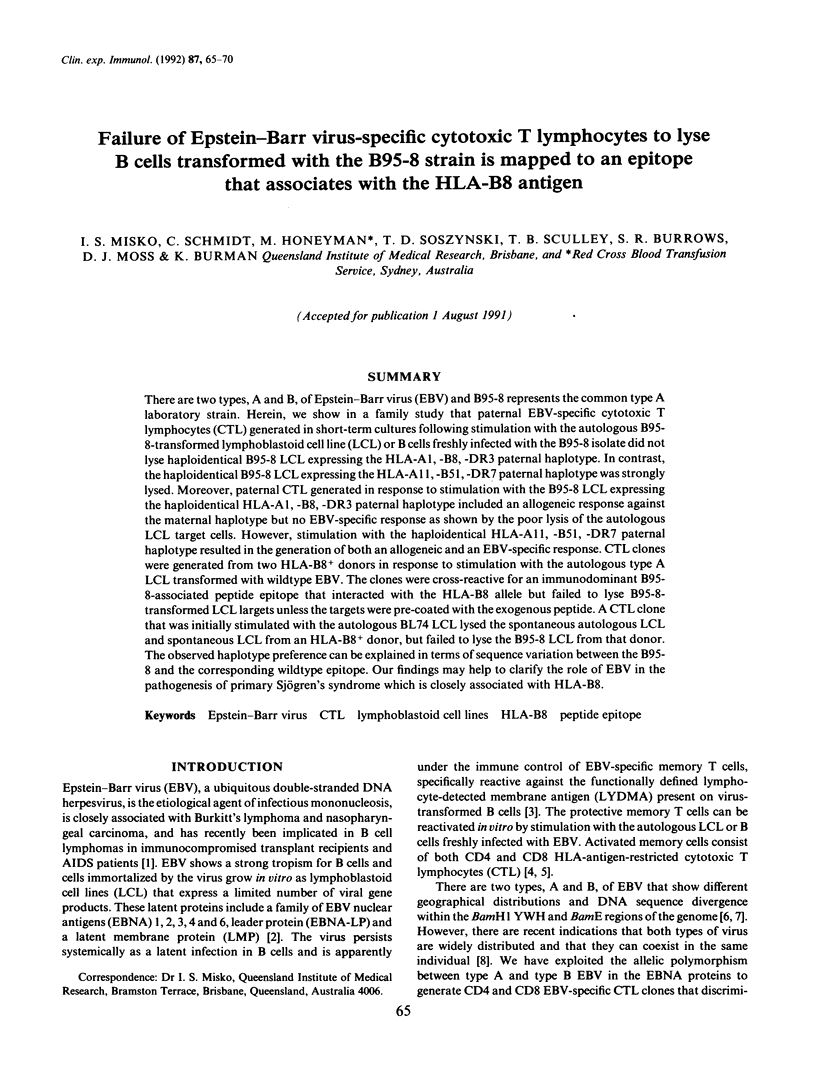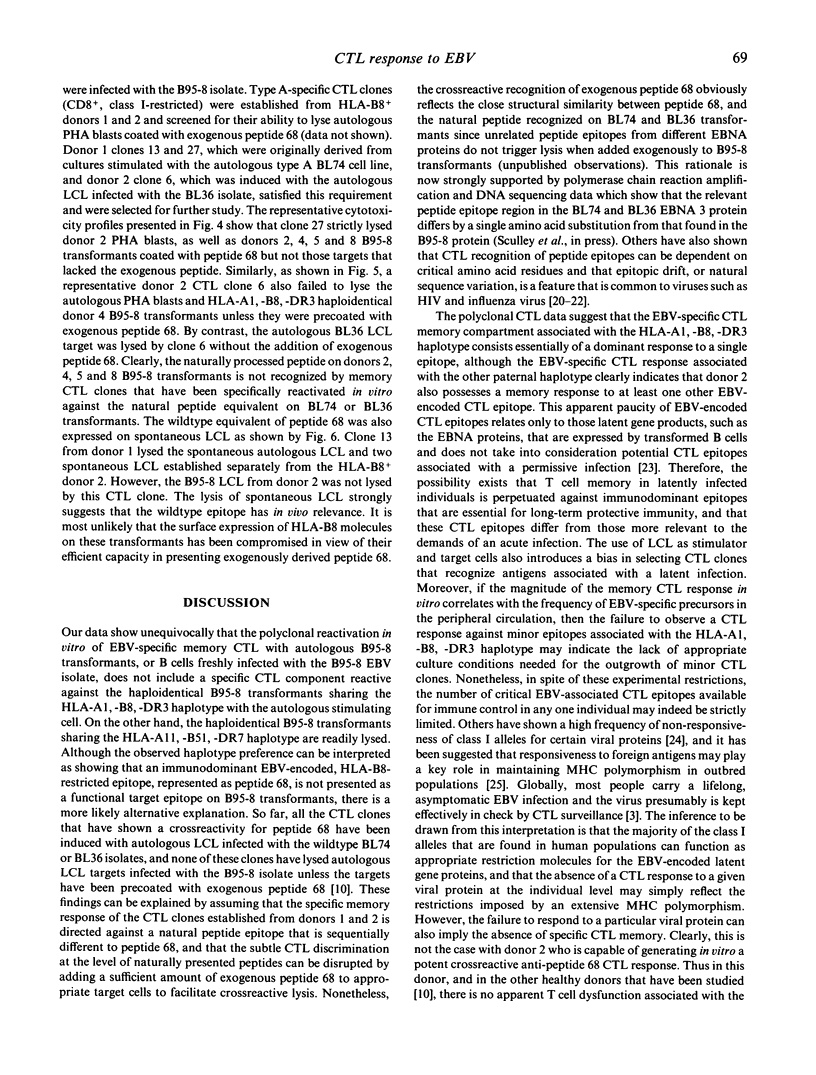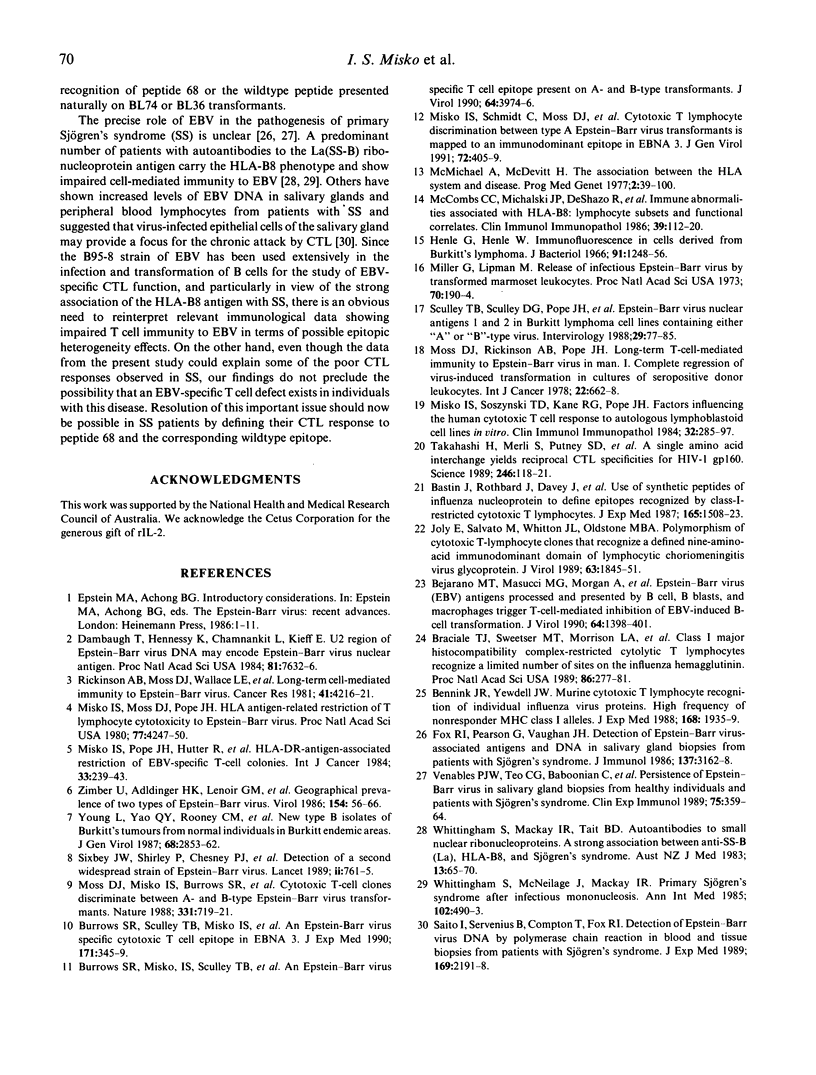Abstract
There are two types, A and B, of Epstein-Barr virus (EBV) and B95-8 represents the common type A laboratory strain. Herein, we show in a family study that paternal EBV-specific cytotoxic T lymphocytes (CTL) generated in short-term cultures following stimulation with the autologous B95-8-transformed lymphoblastoid cell line (LCL) or B cells freshly infected with the B95-8 isolate did not lyse haploidentical B95-8 LCL expressing the HLA-A1, -B8, -DR3 paternal haplotype. In contrast, the haploidentical B95-8 LCL expressing the HLA-A11, -B51, -DR7 paternal haplotype was strongly lysed. Moreover, paternal CTL generated in response to stimulation with the B95-8 LCL expressing the haploidentical HLA-A1, -B8, -DR3 paternal haplotype included an allogeneic response against the maternal haplotype but no EBV-specific response as shown by the poor lysis of the autologous LCL target cells. However, stimulation with the haploidentical HLA-A11, -B51, -DR7 paternal haplotype resulted in the generation of both an allogeneic and an EBV-specific response. CTL clones were generated from two HLA-B8+ donors in response to stimulation with the autologous type A LCL transformed with wildtype EBV. The clones were cross-reactive for an immunodominant B95-8-associated peptide epitope that interacted with the HLA-B8 allele but failed to lyse B95-8-transformed LCL targets unless the targets were pre-coated with the exogenous peptide. A CTL clone that was initially stimulated with the autologous BL74 LCL lysed the spontaneous autologous LCL and spontaneous LCL from an HLA-B8+ donor, but failed to lyse the B95-8 LCL from that donor. The observed haplotype preference can be explained in terms of sequence variation between the B95-8 and the corresponding wildtype epitope. Our findings may help to clarify the role of EBV in the pathogenesis of primary Sjögren's syndrome which is closely associated with HLA-B8.
Full text
PDF





Selected References
These references are in PubMed. This may not be the complete list of references from this article.
- Bastin J., Rothbard J., Davey J., Jones I., Townsend A. Use of synthetic peptides of influenza nucleoprotein to define epitopes recognized by class I-restricted cytotoxic T lymphocytes. J Exp Med. 1987 Jun 1;165(6):1508–1523. doi: 10.1084/jem.165.6.1508. [DOI] [PMC free article] [PubMed] [Google Scholar]
- Bejarano M. T., Masucci M. G., Morgan A., Morein B., Klein G., Klein E. Epstein-Barr virus (EBV) antigens processed and presented by B cells, B blasts, and macrophages trigger T-cell-mediated inhibition of EBV-induced B-cell transformation. J Virol. 1990 Mar;64(3):1398–1401. doi: 10.1128/jvi.64.3.1398-1401.1990. [DOI] [PMC free article] [PubMed] [Google Scholar]
- Bennink J. R., Yewdell J. W. Murine cytotoxic T lymphocyte recognition of individual influenza virus proteins. High frequency of nonresponder MHC class I alleles. J Exp Med. 1988 Nov 1;168(5):1935–1939. doi: 10.1084/jem.168.5.1935. [DOI] [PMC free article] [PubMed] [Google Scholar]
- Braciale T. J., Sweetser M. T., Morrison L. A., Kittlesen D. J., Braciale V. L. Class I major histocompatibility complex-restricted cytolytic T lymphocytes recognize a limited number of sites on the influenza hemagglutinin. Proc Natl Acad Sci U S A. 1989 Jan;86(1):277–281. doi: 10.1073/pnas.86.1.277. [DOI] [PMC free article] [PubMed] [Google Scholar]
- Burrows S. R., Misko I. S., Sculley T. B., Schmidt C., Moss D. J. An Epstein-Barr virus-specific cytotoxic T-cell epitope present on A- and B-type transformants. J Virol. 1990 Aug;64(8):3974–3976. doi: 10.1128/jvi.64.8.3974-3976.1990. [DOI] [PMC free article] [PubMed] [Google Scholar]
- Burrows S. R., Sculley T. B., Misko I. S., Schmidt C., Moss D. J. An Epstein-Barr virus-specific cytotoxic T cell epitope in EBV nuclear antigen 3 (EBNA 3). J Exp Med. 1990 Jan 1;171(1):345–349. doi: 10.1084/jem.171.1.345. [DOI] [PMC free article] [PubMed] [Google Scholar]
- Dambaugh T., Hennessy K., Chamnankit L., Kieff E. U2 region of Epstein-Barr virus DNA may encode Epstein-Barr nuclear antigen 2. Proc Natl Acad Sci U S A. 1984 Dec;81(23):7632–7636. doi: 10.1073/pnas.81.23.7632. [DOI] [PMC free article] [PubMed] [Google Scholar]
- Fox R. I., Pearson G., Vaughan J. H. Detection of Epstein-Barr virus-associated antigens and DNA in salivary gland biopsies from patients with Sjogren's syndrome. J Immunol. 1986 Nov 15;137(10):3162–3168. [PubMed] [Google Scholar]
- Henle G., Henle W. Immunofluorescence in cells derived from Burkitt's lymphoma. J Bacteriol. 1966 Mar;91(3):1248–1256. doi: 10.1128/jb.91.3.1248-1256.1966. [DOI] [PMC free article] [PubMed] [Google Scholar]
- Joly E., Salvato M., Whitton J. L., Oldstone M. B. Polymorphism of cytotoxic T-lymphocyte clones that recognize a defined nine-amino-acid immunodominant domain of lymphocytic choriomeningitis virus glycoprotein. J Virol. 1989 May;63(5):1845–1851. doi: 10.1128/jvi.63.5.1845-1851.1989. [DOI] [PMC free article] [PubMed] [Google Scholar]
- McCombs C. C., Michalski J. P., deShazo R., Bozelka B., Lane J. T. Immune abnormalities associated with HLA-B8: lymphocyte subsets and functional correlates. Clin Immunol Immunopathol. 1986 Apr;39(1):112–120. doi: 10.1016/0090-1229(86)90210-2. [DOI] [PubMed] [Google Scholar]
- McMichael A., McDevitt H. The association between the HLA system and disease. Prog Med Genet. 1977;2:39–100. [PubMed] [Google Scholar]
- Miller G., Lipman M. Release of infectious Epstein-Barr virus by transformed marmoset leukocytes. Proc Natl Acad Sci U S A. 1973 Jan;70(1):190–194. doi: 10.1073/pnas.70.1.190. [DOI] [PMC free article] [PubMed] [Google Scholar]
- Misko I. S., Moss D. J., Pope J. H. HLA antigen-related restriction of T lymphocyte cytotoxicity to Epstein-Barr virus. Proc Natl Acad Sci U S A. 1980 Jul;77(7):4247–4250. doi: 10.1073/pnas.77.7.4247. [DOI] [PMC free article] [PubMed] [Google Scholar]
- Misko I. S., Pope J. H., Hütter R., Soszynski T. D., Kane R. G. HLA-DR-antigen-associated restriction of EBV-specific cytotoxic T-cell colonies. Int J Cancer. 1984 Feb 15;33(2):239–243. doi: 10.1002/ijc.2910330212. [DOI] [PubMed] [Google Scholar]
- Misko I. S., Schmidt C., Moss D. J., Burrows S. R., Sculley T. B. Cytotoxic T lymphocyte discrimination between type A Epstein-Barr virus transformants is mapped to an immunodominant epitope in EBNA 3. J Gen Virol. 1991 Feb;72(Pt 2):405–409. doi: 10.1099/0022-1317-72-2-405. [DOI] [PubMed] [Google Scholar]
- Misko I. S., Soszynski T. D., Kane R. G., Pope J. H. Factors influencing the human cytotoxic T cell response to autologous lymphoblastoid cell lines in vitro. Clin Immunol Immunopathol. 1984 Sep;32(3):285–297. doi: 10.1016/0090-1229(84)90273-3. [DOI] [PubMed] [Google Scholar]
- Moss D. J., Misko I. S., Burrows S. R., Burman K., McCarthy R., Sculley T. B. Cytotoxic T-cell clones discriminate between A- and B-type Epstein-Barr virus transformants. Nature. 1988 Feb 25;331(6158):719–721. doi: 10.1038/331719a0. [DOI] [PubMed] [Google Scholar]
- Moss D. J., Rickinson A. B., Pope J. H. Long-term T-cell-mediated immunity to Epstein-Barr virus in man. I. Complete regression of virus-induced transformation in cultures of seropositive donor leukocytes. Int J Cancer. 1978 Dec;22(6):662–668. doi: 10.1002/ijc.2910220604. [DOI] [PubMed] [Google Scholar]
- Rickinson A. B., Moss D. J., Wallace L. E., Rowe M., Misko I. S., Epstein M. A., Pope J. H. Long-term T-cell-mediated immunity to Epstein-Barr virus. Cancer Res. 1981 Nov;41(11 Pt 1):4216–4221. [PubMed] [Google Scholar]
- Saito I., Servenius B., Compton T., Fox R. I. Detection of Epstein-Barr virus DNA by polymerase chain reaction in blood and tissue biopsies from patients with Sjogren's syndrome. J Exp Med. 1989 Jun 1;169(6):2191–2198. doi: 10.1084/jem.169.6.2191. [DOI] [PMC free article] [PubMed] [Google Scholar]
- Sculley T. B., Sculley D. G., Pope J. H., Bornkamm G. W., Lenoir G. M., Rickinson A. B. Epstein-Barr virus nuclear antigens 1 and 2 in Burkitt lymphoma cell lines containing either 'A'- or 'B'-type virus. Intervirology. 1988;29(2):77–85. doi: 10.1159/000150032. [DOI] [PubMed] [Google Scholar]
- Sixbey J. W., Shirley P., Chesney P. J., Buntin D. M., Resnick L. Detection of a second widespread strain of Epstein-Barr virus. Lancet. 1989 Sep 30;2(8666):761–765. doi: 10.1016/s0140-6736(89)90829-5. [DOI] [PubMed] [Google Scholar]
- Takahashi H., Merli S., Putney S. D., Houghten R., Moss B., Germain R. N., Berzofsky J. A. A single amino acid interchange yields reciprocal CTL specificities for HIV-1 gp160. Science. 1989 Oct 6;246(4926):118–121. doi: 10.1126/science.2789433. [DOI] [PubMed] [Google Scholar]
- Venables P. J., Teo C. G., Baboonian C., Griffin B. E., Hughes R. A. Persistence of Epstein-Barr virus in salivary gland biopsies from healthy individuals and patients with Sjögren's syndrome. Clin Exp Immunol. 1989 Mar;75(3):359–364. [PMC free article] [PubMed] [Google Scholar]
- Whittingham S., McNeilage J., Mackay I. R. Primary Sjögren's syndrome after infectious mononucleosis. Ann Intern Med. 1985 Apr;102(4):490–493. doi: 10.7326/0003-4819-102-4-490. [DOI] [PubMed] [Google Scholar]
- Young L. S., Yao Q. Y., Rooney C. M., Sculley T. B., Moss D. J., Rupani H., Laux G., Bornkamm G. W., Rickinson A. B. New type B isolates of Epstein-Barr virus from Burkitt's lymphoma and from normal individuals in endemic areas. J Gen Virol. 1987 Nov;68(Pt 11):2853–2862. doi: 10.1099/0022-1317-68-11-2853. [DOI] [PubMed] [Google Scholar]
- Zimber U., Adldinger H. K., Lenoir G. M., Vuillaume M., Knebel-Doeberitz M. V., Laux G., Desgranges C., Wittmann P., Freese U. K., Schneider U. Geographical prevalence of two types of Epstein-Barr virus. Virology. 1986 Oct 15;154(1):56–66. doi: 10.1016/0042-6822(86)90429-0. [DOI] [PubMed] [Google Scholar]


